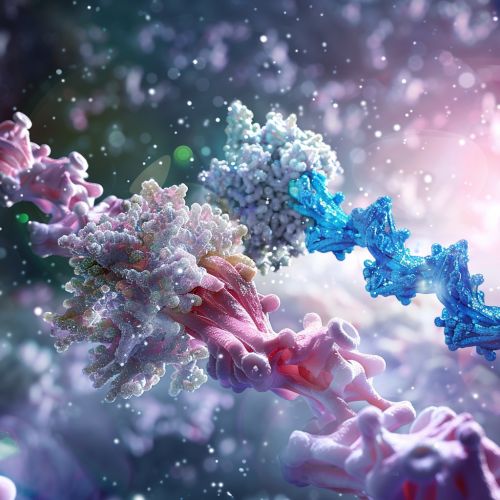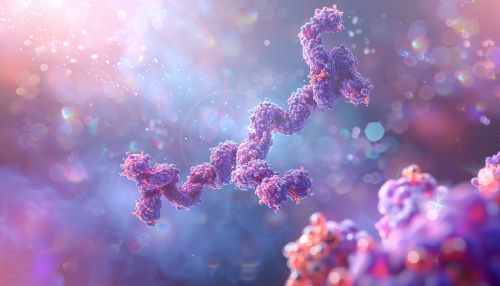Protein–protein interaction
Introduction
Protein–protein interactions (PPIs) are fundamental to virtually all biological processes. These interactions occur when two or more protein molecules bind together, often to carry out their biological functions. PPIs are critical for various cellular processes, including signal transduction, immune responses, and the regulation of cellular activities. Understanding PPIs is essential for elucidating the mechanisms of diseases and for the development of therapeutic strategies.
Types of Protein–Protein Interactions
Protein–protein interactions can be classified into several types based on their nature, duration, and function. These include transient and stable interactions, obligate and non-obligate interactions, and homo- and hetero-oligomeric interactions.
Transient vs. Stable Interactions
- **Transient Interactions:** These are temporary interactions that occur and dissociate quickly. They are often involved in signaling pathways and regulatory mechanisms. For example, the interaction between a kinase and its substrate is typically transient.
- **Stable Interactions:** These interactions are more permanent and form stable complexes. Examples include the subunits of hemoglobin, which remain associated to perform their function of oxygen transport.
Obligate vs. Non-obligate Interactions
- **Obligate Interactions:** These interactions are essential for the stability and function of the proteins involved. The proteins cannot exist independently in their functional form. For instance, the subunits of ATP synthase are obligate interactors.
- **Non-obligate Interactions:** These proteins can exist independently but interact under specific conditions. An example is the interaction between transcription factors and DNA-binding proteins.
Homo-oligomeric vs. Hetero-oligomeric Interactions
- **Homo-oligomeric Interactions:** These involve the binding of identical protein molecules. An example is the dimerization of enzymes like lactate dehydrogenase.
- **Hetero-oligomeric Interactions:** These involve different protein molecules. For example, the interaction between cytochrome c and cytochrome c oxidase in the electron transport chain.
Mechanisms of Protein–Protein Interactions
The mechanisms underlying PPIs are diverse and can be driven by various forces and structural compatibilities. These include hydrophobic interactions, hydrogen bonds, ionic interactions, and van der Waals forces.
Hydrophobic Interactions
Hydrophobic interactions play a significant role in PPIs, particularly in the formation of protein cores. Non-polar amino acid residues tend to cluster together away from the aqueous environment, driving the interaction.
Hydrogen Bonds
Hydrogen bonds are crucial for the specificity and stability of PPIs. They occur between polar side chains and backbone atoms of the interacting proteins, contributing to the precise alignment necessary for functional interactions.
Ionic Interactions
Ionic interactions, or salt bridges, occur between oppositely charged side chains of amino acids. These interactions are particularly important in the initial recognition and binding phases of PPIs.
Van der Waals Forces
Van der Waals forces are weak, non-specific interactions that contribute to the overall stability of PPIs. They arise from transient dipoles induced in the interacting molecules.
Methods for Studying Protein–Protein Interactions
Several experimental and computational methods are employed to study PPIs. These methods can be broadly categorized into in vitro, in vivo, and in silico approaches.
In Vitro Methods
- **Co-immunoprecipitation (Co-IP):** This technique involves the use of specific antibodies to precipitate a protein of interest along with its interacting partners from a cell lysate.
- **Yeast Two-Hybrid (Y2H) System:** This genetic approach detects PPIs by reconstituting a functional transcription factor when two proteins of interest interact in yeast cells.
- **Surface Plasmon Resonance (SPR):** SPR measures the binding kinetics and affinity of PPIs in real-time without the need for labeling the proteins.
In Vivo Methods
- **Fluorescence Resonance Energy Transfer (FRET):** FRET detects PPIs by measuring energy transfer between two fluorescently labeled proteins in living cells.
- **Bimolecular Fluorescence Complementation (BiFC):** BiFC involves the reconstitution of a fluorescent protein when two proteins of interest interact, allowing visualization of PPIs in live cells.
In Silico Methods
- **Molecular Docking:** Computational docking predicts the preferred orientation of one protein when bound to another, providing insights into the interaction interface.
- **Molecular Dynamics (MD) Simulations:** MD simulations provide detailed information on the dynamics and stability of PPIs over time.
Functional Implications of Protein–Protein Interactions
PPIs are integral to numerous cellular functions and processes. They play a critical role in signal transduction, metabolic pathways, and the regulation of gene expression.
Signal Transduction
PPIs are central to signal transduction pathways, where they facilitate the transmission of signals from the cell surface to the nucleus. For example, the interaction between receptor tyrosine kinases and downstream signaling proteins is essential for the activation of various cellular responses.
Metabolic Pathways
In metabolic pathways, PPIs enable the formation of multi-enzyme complexes that enhance the efficiency of biochemical reactions. The pyruvate dehydrogenase complex is an example of such a multi-enzyme complex involved in cellular respiration.
Gene Regulation
PPIs are crucial for the regulation of gene expression. Transcription factors often interact with co-activators or co-repressors to modulate the transcription of specific genes. The interaction between p53 and MDM2 is a well-known example of a regulatory PPI involved in cell cycle control and apoptosis.
Protein–Protein Interaction Networks
Protein–protein interaction networks (PPINs) provide a comprehensive view of the interactions within a cell. These networks are often represented as graphs, where nodes represent proteins and edges represent interactions.
Construction of PPINs
PPINs are constructed using data from various high-throughput techniques such as yeast two-hybrid screens, mass spectrometry, and computational predictions. These networks help in understanding the complexity and organization of cellular processes.
Analysis of PPINs
The analysis of PPINs involves identifying key proteins, or hubs, that have a high degree of connectivity. These hubs are often essential for cellular viability and can be potential targets for therapeutic intervention. Network motifs, or recurring patterns of interactions, are also analyzed to understand the functional modules within the network.
Applications of Protein–Protein Interaction Studies
The study of PPIs has several applications in biomedical research, drug discovery, and biotechnology.
Drug Discovery
PPIs are attractive targets for drug discovery, as disrupting or stabilizing specific interactions can modulate disease pathways. Small molecules, peptides, and antibodies are being developed to target PPIs in various diseases, including cancer and neurodegenerative disorders.
Biomarker Discovery
PPIs can serve as biomarkers for disease diagnosis and prognosis. Changes in the interaction patterns of specific proteins can indicate the presence or progression of a disease. For example, alterations in the interaction network of amyloid-beta are associated with Alzheimer's disease.
Synthetic Biology
In synthetic biology, PPIs are engineered to create novel biological systems and pathways. By designing synthetic protein interactions, researchers can develop new therapeutic strategies, biosensors, and bio-manufacturing processes.
Challenges and Future Directions
Despite significant advancements, several challenges remain in the study of PPIs. These include the dynamic nature of interactions, the complexity of interaction networks, and the need for high-throughput and high-resolution techniques.
Dynamic Nature of Interactions
The transient and context-dependent nature of many PPIs makes them difficult to capture and study. Advanced techniques such as single-molecule imaging and real-time interaction assays are being developed to address this challenge.
Complexity of Interaction Networks
The sheer complexity of PPINs poses a challenge for data analysis and interpretation. Integrating multi-omics data and developing sophisticated computational models are essential for a comprehensive understanding of PPINs.
High-Throughput and High-Resolution Techniques
There is a need for high-throughput techniques that can provide high-resolution data on PPIs. Techniques such as cryo-electron microscopy and cross-linking mass spectrometry are promising tools for achieving this goal.
Conclusion
Protein–protein interactions are fundamental to the functioning of biological systems. Understanding these interactions at a detailed level is crucial for elucidating cellular mechanisms and developing therapeutic strategies. Advances in experimental and computational methods continue to enhance our ability to study PPIs, paving the way for new discoveries and applications in biomedical research and biotechnology.


